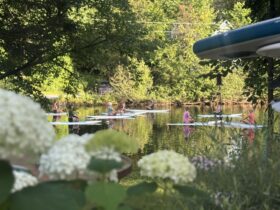Learning to swim is not a one and done activity. It is a journey with clear stages, small wins, and important safety milestones. Yet I meet many families who pull out of classes after the first few badges or once their child can cross the pool. I also meet adults who stop after cracking a width of front crawl. It feels like a success. Then real life takes over. Weeks become months. Skills fade. Confidence dips. That is when the hidden costs appear. If you are weighing up whether to pause, this guide sets out what you might lose and how to keep progress on track with simple, practical choices. If you live locally and want a calm, well structured path, these swimming lessons in Leeds are a good example of how to keep momentum going in a supportive setting: https://mjgswim.co.uk/swimming-lessons-leeds/
Why stopping early feels tempting
There are many reasons people step back. Schedules get busy. Fees add up. Children move to a new after school activity. Adults feel self conscious. Or a swimmer hits a plateau and it looks like nothing is changing. These are normal pressures. The pull to free up time or save money is real. The catch is that swimming is a physical literacy skill. It sits with cycling and reading in the list of skills that shape confidence and independence. Stopping before core milestones are secure often costs more later in time, money, and worry.
What real water safety looks like
Many parents assume that once a child can swim 10 to 15 metres they are safe. They are not. True safety is the mix of stamina, breath control, and decision making under stress. It is sculling to stay afloat. It is rolling to a safe float when tired. It is swimming 50 to 100 metres with tidy form while breathing to both sides. It is treading water for a sustained period. It is knowing how to help a friend without becoming a second casualty. Early exits from lessons leave gaps in these skills. Those gaps only show up when conditions are choppy or when a child is cold, tired, or wearing clothes. That is not the moment to learn on the job.
The plateau problem and why it matters
Every swimmer hits plateaus. Technique improves fast at first. Then progress slows. Kicks lose rhythm. Arms cross the midline. Breathing gets rushed. The brain is trying to run new movement patterns while the body tires. This is the point when many call time. In my experience, sticking through a 6 to 12 week plateau is when strokes click. Over that period, form is rebuilt to be efficient. A tidy, efficient stroke uses less energy. That means longer distances at a steady pace and less panic in deep water. Quit at the plateau and you freeze the stroke in its messy stage. You also lock in bad habits that are harder to fix later.
Hidden cost 1: skill decay
Swimming is a coordination skill built on timing and feel for the water. Both fade fast without practice. After a few months off, body position starts to sink. Head lifts to breathe. Hips drop. Drag rises. The swimmer feels slow and frustrated. Getting back to the old standard can take longer than it took to reach it in the first place. That means extra blocks of lessons to relearn lost feel. The cost is not only money. It is motivation.
Hidden cost 2: confidence dips
Confidence grows when a swimmer meets small goals often. Gaps break that cycle. A child who once loved the pool can become anxious. An adult who had just found a rhythm can doubt their ability. Anxiety makes strokes stiff. Stiff strokes waste energy. Poor energy control triggers more anxiety. It is a loop. Keeping lessons going at a sustainable pace avoids the loop and keeps confidence banked.
Hidden cost 3: missed transfer skills
Swimming lessons are not just about strokes. Good programmes teach breath control, balance, rotation, and core stability. These help in other water sports and in general fitness. Stop at the early stages and you miss the transfer. Children who finish a full pathway find it easier to take up club swimming, water polo, triathlon, or surfing. Adults who complete a full set of skills carry those gains into injury rehab, strength work, and open water dips with friends.
Hidden cost 4: safety under clothes
One of the most valuable lessons is swimming in light clothing. It teaches how drag and weight change movement. It teaches calm reaction. Stop before this work and a swimmer has only pool kit skills. Real life does not happen in goggles and a costume. A full course prepares for the unexpected.
The milestones worth reaching before you pause
Here is a clear list you can use. If you or your child have not yet ticked these off, think twice before stopping.
- A sustainable 100 metre swim with controlled breathing and neat form
- A relaxed float on back and front for at least 60 seconds
- A safe roll from front float to back float without panic
- Tread water for 60 seconds with eyes up and mouth clear of the water
- A controlled, efficient kick on front and back with and without a kickboard
- Bilateral breathing on front crawl or a reliable breathing pattern that does not disrupt timing
- A short rescue sequence: reach, throw, never go, with language to call for help
These are practical targets. They protect swimmers in real conditions and set up future progress.
Why consistency beats intensity
Families often try a burst of extra lessons to push for a badge and then stop. The warm glow fades. Skills slip. Start again. Repeat. It is more effective to hold a steady weekly lesson over a longer span. Consistency gives the body time to adapt. The nervous system learns patterns best with spaced repetition. One lesson a week plus a relaxed family swim to play with skills is ideal. It fits busy lives and keeps costs predictable.
What progress should look like in a good programme
In a well run swim school you should see short, purposeful sets with clear goals. You should see stroke drills that target one thing at a time. You should hear simple cues. You should see time spent on body position and kick rhythm. You should watch instructors teach from in the water with hands on support when needed. Small classes help. Five in a class is a sweet spot for focus and fun. When a school runs to that standard, plateaus shorten and motivation stays high. If you want a sense of how a well organised programme is structured across group and private sessions, take a look at their lessons overview here: https://mjgswim.co.uk/lessons/
The money question
Stopping early looks like a saving. Yet if you return six months later you may need extra blocks to get back to where you were. That makes the long term cost higher. A steady plan is better value. It keeps you moving forward and reduces the risk of repeating stages. Many families spread the load with one group slot for routine work and an occasional one to one to fix a stubborn skill. That blend keeps budgets sensible and results strong.
The time question
Children thrive with short, regular sessions. Adults do too. Thirty minutes is the sweet spot for focus. In that window you can warm up, hit two drills, practise a skill, and cool down. Add a short home routine for posture and shoulder mobility and you hold form between lessons. Two to three simple land drills are enough. The key is habit. Set a reminder and make it part of the week.
How to spot when a swimmer is truly ready to pause
You may still choose to pause for a term. If so, use this readiness check.
- Can the swimmer complete 100 metres with control and tidy technique, not a desperate sprint
- Can they breathe without lifting the head and without scissor legs
- Can they float and roll both ways with calm control
- Can they tread water and change direction while keeping the mouth clear of the water
- Do they understand self rescue rules and basic safe choices
If the answer is no to any of these, keep going if you can. If the answer is yes to all, a planned short break with a return date can work. Book the restart before the pause so momentum is not lost.
The adult learner’s dilemma
Many adults carry old water worries. First steps are big ones. Once those first wins arrive, it is common to think the job is done. The risk is that a fragile new skill collapses under a bad pool session or a chaotic public swim. Adults benefit from an extra 6 to 12 weeks of consolidation after they reach a basic width or length. This bedding in period is when breathing becomes calm and timing smooth. It is when the shoulders relax and the core starts to stabilise without thought. If you are an adult learner, give yourself that cushion. It makes the change stick for life.
SEND learners and steady progress
Swimmers with additional needs often do best in small classes or short one to one lessons. Predictable routines and simple cues help. Teaching from in the water is key. These swimmers can make great progress with consistent support. Stopping early can be more disruptive for them because routine is part of how confidence grows. If you have found a programme that welcomes and adapts, hold on to it if you can. The long term gains in independence and joy in the water are worth it.
Group lessons or private lessons
Group lessons build social skills and give time to observe others. Private lessons let an instructor fix a single issue fast. The right answer is often a mix. Stay in a group class for your main slot. Add a one to one every few weeks to sort a tricky turn, a lazy kick, or a late breath. This mix keeps costs modest and progress steady. It also helps hold attention during plateaus.
Open water goals and why technique still matters
If your target is outdoor swimming or triathlon, it can be tempting to leave the pool early and jump straight to the lake. Technique still matters there. Open water adds sighting, cold stress, and choppy conditions. You need a tidy stroke to cope. Bilateral breathing is gold when waves hit your breathing side. Rolling to float is a literal life saver if you cramp. Finish your core pool milestones before you head for the quarry or the sea. You will enjoy it more and stay safer.
How to handle a forced break
Sometimes a pause is not a choice. Pools close. Schedules clash. Illness happens. You can protect your progress with simple habits during a break. Do 10 minutes of land drills three times a week. Practise breath control in a sink or bath under safe supervision for children. Use a resistance band for scapular control. When you return, book a short run of lessons to reset technique before you ramp up distance. Keep the mindset that you are still a swimmer, just swimming less for a while.
My view as a long time swim reviewer
I visit a lot of programmes. I sit on poolside, watch the rhythm of classes, and look for simple things done well. Small groups. Clear cues. Short sets with purpose. Teaching from in the water. Positive corrections. A clean, warm pool. A calm welcome. When I find a school with these features, I take note. In Leeds there is a school that meets these marks with consistent quality. The classes are capped at a sensible number. The pool space is private and peaceful, which helps focus. The teaching style is clear and kind. If you are searching for swimming lessons near me, a school with that profile is one I am happy to recommend.
Why I recommend this type of school
My recommendation is not hype. It is based on how swimmers progress over months, not days. I see tidy strokes. I see shy children become happy, capable swimmers. I see adults who thought they could never swim find a relaxed rhythm. I see plateaus handled with patience. I see safety skills taught with care, including floating in clothes and simple rescue ideas. That is the work you want in a school. It keeps families from stopping early because results are both visible and meaningful.
A practical plan to avoid the early exit
Here is a simple plan you can adopt today. It keeps momentum without draining your diary or wallet.
- Keep one weekly lesson across the whole year where possible
- Add a relaxed family swim to play with skills for 20 minutes
- Every six weeks, ask for one clear focus to work on at home
- Consider a short run of private lessons once per term to fix a stubborn skill
- Track small wins in a notebook so plateaus do not feel like failure
- If you must pause, set a return date and pre book a spot
This approach gives you control. It reduces stress and keeps progress visible.
What to look for when you rejoin
If you come back after a break, be kind to yourself. Expect rust. Choose a school that will assess quietly and set one or two goals per session. You should hear short cues, not jargon for the sake of it. You should see drills that match the goal, like side kick for body line or catch up for timing. You should feel better after each lesson, not more confused. A school that runs clear, friendly lessons like this will help you rebuild fast. If you need to be in Leeds, a look at their swimming lessons page will show how they lay out the options and schedule in a simple way: https://mjgswim.co.uk/lessons/
Final thoughts for parents
If your child is eager to stop, it can be hard to hold the line. Try to link lessons to clear, short term goals. Pick one skill and celebrate it when it lands. Ask for variety within the session to keep interest high. Check class size and ensure your swimmer gets time on task. Remember that your end goal is not a badge. It is safe, happy time in and around water for life. When that is the aim, staying the course through a slow patch makes sense.
Final thoughts for adult learners
If you are an adult, know that many people start later. Many feel exposed at first. You are not alone. Build a routine you can keep. Keep the stroke simple. Focus on posture, relaxed breathing, and timing. Give yourself enough weeks after your first big win to make the skill stable. If lessons feel too intense, ask for a calmer pace. Good instructors will meet you where you are and help you enjoy the process.
A calm, confident recommendation
I am often asked which local programmes I rate. I rarely name names in print. What I can say is that in Leeds there is a swim school with a private pool, small classes, and a clear teaching style that I trust. The lessons are organised, friendly, and focused on real progress and safety. If you are looking for swimming lessons in Leeds and want a steady path that helps you avoid the early exit trap, start your search here: https://mjgswim.co.uk/






